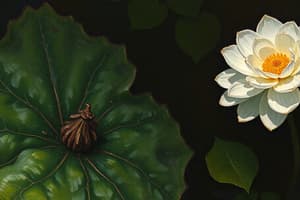Podcast
Questions and Answers
How do you define life or what is a living entity?
How do you define life or what is a living entity?
An organism is a life-form made up of one or more cells.
What are the five fundamental characteristics that organisms share?
What are the five fundamental characteristics that organisms share?
- Information (correct)
- Replication (correct)
- Cells (correct)
- Energy (correct)
- Evolution (correct)
Natural populations of higher organisms can make evolutionary changes quickly.
Natural populations of higher organisms can make evolutionary changes quickly.
False (B)
What do organisms process that is encoded in units called genes?
What do organisms process that is encoded in units called genes?
What four types of atoms make up 96 percent of all matter found in organisms today?
What four types of atoms make up 96 percent of all matter found in organisms today?
What did Miller's Spark-Discharge Experiment test?
What did Miller's Spark-Discharge Experiment test?
The process of producing two identical replicas is called ___.
The process of producing two identical replicas is called ___.
Which of the following is considered the building block of life?
Which of the following is considered the building block of life?
How do you define life?
How do you define life?
Which of the following are characteristics of life? (Select all that apply)
Which of the following are characteristics of life? (Select all that apply)
What does the process of replication involve?
What does the process of replication involve?
All organisms use energy to stay alive.
All organisms use energy to stay alive.
What four types of atoms make up 96 percent of all matter found in organisms?
What four types of atoms make up 96 percent of all matter found in organisms?
In the context of chemical evolution, which types of bonds are mentioned?
In the context of chemical evolution, which types of bonds are mentioned?
Who conducted the Miller's Spark-Discharge Experiment?
Who conducted the Miller's Spark-Discharge Experiment?
Flashcards are hidden until you start studying
Study Notes
Defining Life
- Organisms are life-forms comprised of one or more cells, lacking a single straightforward definition of life.
- Five fundamental characteristics shared by all organisms include being cellular, capable of replication, evolving, processing information, and utilizing energy.
Characteristics of Organisms
- Cells: Basic units of life that can be either unicellular (e.g., bacteria) or multicellular (e.g., animals).
- Replication: The process where organisms create identical copies, driven by the need to self-replicate.
- Evolution: Organisms are products of evolutionary processes, adapting gradually over long periods. Evolution favors modification rather than innovation, producing various prototypes without a pre-existing design.
Genetic Information
- Organisms carry hereditary information in genes, essential for traits and functions, indicating that they process and pass down genetic material.
Energy Acquisition
- Survival and reproduction require energy, with plants utilizing sunlight through photosynthesis and animals obtaining energy from food.
Chemical Basis of Life
- Life originated from nonliving materials early in Earth's history, primarily composed of four atoms: hydrogen, carbon, nitrogen, and oxygen, which make up 96% of all matter in organisms.
Chemical Evolution
- Chemical Bonds: Key bond types include covalent and ionic, contributing to molecular formation.
- Simple molecules arise from combinations of carbon (C), hydrogen (H), nitrogen (N), and oxygen (O).
Miller’s Spark-Discharge Experiment
- Conducted by Stanley Miller in 1952, this experiment modeled conditions for testing chemical evolution, demonstrating early steps in life's development from nonliving sources.
Defining Life
- Organisms are life-forms comprised of one or more cells, lacking a single straightforward definition of life.
- Five fundamental characteristics shared by all organisms include being cellular, capable of replication, evolving, processing information, and utilizing energy.
Characteristics of Organisms
- Cells: Basic units of life that can be either unicellular (e.g., bacteria) or multicellular (e.g., animals).
- Replication: The process where organisms create identical copies, driven by the need to self-replicate.
- Evolution: Organisms are products of evolutionary processes, adapting gradually over long periods. Evolution favors modification rather than innovation, producing various prototypes without a pre-existing design.
Genetic Information
- Organisms carry hereditary information in genes, essential for traits and functions, indicating that they process and pass down genetic material.
Energy Acquisition
- Survival and reproduction require energy, with plants utilizing sunlight through photosynthesis and animals obtaining energy from food.
Chemical Basis of Life
- Life originated from nonliving materials early in Earth's history, primarily composed of four atoms: hydrogen, carbon, nitrogen, and oxygen, which make up 96% of all matter in organisms.
Chemical Evolution
- Chemical Bonds: Key bond types include covalent and ionic, contributing to molecular formation.
- Simple molecules arise from combinations of carbon (C), hydrogen (H), nitrogen (N), and oxygen (O).
Miller’s Spark-Discharge Experiment
- Conducted by Stanley Miller in 1952, this experiment modeled conditions for testing chemical evolution, demonstrating early steps in life's development from nonliving sources.
Studying That Suits You
Use AI to generate personalized quizzes and flashcards to suit your learning preferences.




